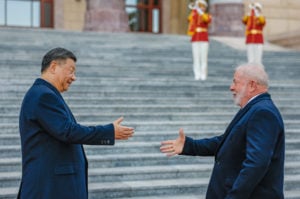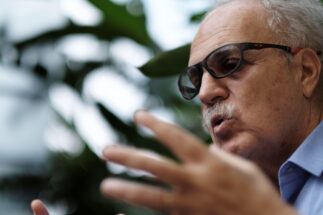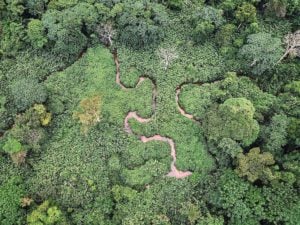Brazilian president Luiz Inácio Lula da Silva’s recent visit to China saw climate issues feature regularly in high-level statements and in several of the agreements signed. Although overshadowed, for many in the west, by Lula’s comments on the war in Ukraine, the trip was a promising start to a new stage in bilateral relations, but the trajectory and language on green cooperation between the two countries remains vague, analysts told Diálogo Chino.
During the three-day visit, which concluded on 14 April, Lula and his Chinese counterpart, Xi Jinping, signed a total of 15 different statements, memoranda and plans.
A high-point of the leaders’ meeting was the joint declaration on climate change, said João Cumarú, a researcher at Plataforma CIPÓ, a climate and foreign affairs NGO. “It is an important step as it shows an interest in advancing cooperation between Brazil and China, both bilaterally and multilaterally, in efforts for planetary protection,” he said.
But China and Brazil must be more explicit about the main threats to tropical forests, said André Vasconcelos, global engagement lead at Trase, a supply chain transparency initiative.
Observers were also left frustrated over a lack of progress on carbon markets, which some had hoped would feature in discussions. “Brazil and China could work together to promote technology transfer and attract investments for carbon sequestration projects in Brazil and in other Amazonian countries,” said Karin Costa Vazquez, a Brazilian researcher at Fudan University in Shanghai.
Here we look at four of the key takeaways on climate and the environment from Lula’s highly anticipated state visit to China.
New, vague steps towards green finance
Lula landed in Shanghai on 12 April, and was welcomed by Dilma Rousseff, Brazil’s former president (2011–2016) and a long-time ally. She was recently appointed as the new head of the Shanghai-headquartered New Development Bank (NDB), often dubbed the “BRICS bank” after the multilateral bloc that founded it, made up of Brazil, Russia, India, China and South Africa.
At her inauguration the following day, Lula made calls for the NDB to become the major bank of the developing world, and support countries in fighting hunger, inequality and the climate crisis. “For the first time, a development bank with a global scope has been established without the participation of developed countries in its initial phase,” Lula said at the event. “It is free from the chains and conditionalities imposed by traditional institutions on emerging economies.”
Brazil has faced setbacks on almost all the sustainable development goals in recent yearsKarin Costa Vazquez, researcher at Shanghai’s Fudan University
In her inaugural speech, Rousseff said that the NDB already plays an important role in supporting projects that promote mitigation and adaptation to climate change. She also said that the bank has “the potential to be a global leader in funding projects that address the most pressing challenges of our time.”
Karin Costa Vazquez said it was positive to see emphasis throughout the visit on the need to fight climate change at the same time as poverty and hunger, including during Rousseff’s inauguration, in Lula’s speeches and in the leaders’ various statements. “Climate action cannot be detached from the economic and social pillars of the 2030 Agenda, particularly in a country such as Brazil, which has faced setbacks on almost all sustainable development goals in recent years,” Vazquez said.
Later in the visit, the ministries of finance from both countries signed a memorandum of understanding to cooperate in financing sustainable development, while Lula and Xi, in their joint statement on climate change, also stated that “Brazil and China will promote policy dialogues and experience sharing on climate investment and finance.” Elsewhere, the Bank of Brazil and the Industrial and Commercial Bank of China (ICBC) signed an MoU to cooperate in fighting climate change. However, beyond these memoranda, no firmer details or commitments for green finance emerged from discussions between the delegations.
Agribusiness advances, but not so green
“China is a great engine for the Brazilian agro-industry,” Lula said in an interview with Chinese state media Xinhua during his visit. Indeed, of Brazil’s ten most exported agricultural products, China is the most important buyer of six, including soy and beef. Potential new deals and market opportunities were therefore top priorities for many officials and business leaders among the Brazilian delegation.
Carlos Fávaro, Brazil’s agriculture minister, has made two recent trips to China. The first came in March, when Lula’s visit was originally scheduled to take place, until the president contracted pneumonia and was forced to postpone. Fávaro first landed in Beijing with a delegation of almost 90 agribusiness leaders in tow, before returning once more this April alongside the presidential team.
Fávaro’s primary concern was to reopen Chinese markets to Brazilian beef, which had been put under embargo in February following the detection of a case of mad cow disease. After just over a month in force, the minister managed to negotiate an end to the ban soon after arriving in Beijing. “First day of the mission in China and we already have the first piece of great news: the Chinese government has just lifted the embargo on Brazilian beef,” he announced.
Fávaro also celebrated the licensing of four new Brazilian meatpackers for exports to China, after four years without any new approvals by the Asian country. The issuing of such licences has often been a murky process, with previous licences coming after intense pressure from pro-agribusiness politicians and authorities, and showing neglect for environmental protocols – at a time when beef production remains the main driver of deforestation in the Amazon.
Meetings in Beijing also saw China and Brazil agree to create a working group to develop a system for electronic certification for animal-based products. The goal is to speed up the process and increase sales while providing information on animals’ health. A new sanitary and quarantine protocol will also safeguard exports to China. But nothing was said about such a certification system’s use in supporting environmental standards.
“Brazil and China could consider jointly developing monitoring and verification systems for traded commodities, targeting especially regions where links to deforestation and clearance are known to be the greatest,” said Vasconcelos from Trase.
Investigations by Trase showed that almost 70% of Brazilian beef sales to China come from the Amazon and Cerrado, biomes facing ongoing deforestation for the expansion of pastures. Exports of soy to China, meanwhile, are increasingly being sourced from Cerrado regions. In 2020, Chinese soy imports were linked to 237,000 hectares of deforestation risk across Brazil, Trase reports.
Belt and Road still a ‘no’ for Brazil
Ahead of Lula’s visit, speculation began anew over whether Brazil would join the Belt and Road Initiative (BRI), China’s flagship global infrastructure strategy. Although some in the new Brazilian government are said to be supportive of possible membership, no indication of any imminent move to do so emerged during last week’s meetings.
“Not participating in the BRI has so far not prevented us from advancing trade and infrastructure with the Chinese,” said Plataforma CIPÓ’s João Cumarú.
Cumarú, who is based in Shanghai and shadowed members of the Brazilian delegation, said that Brazil already has a well-established channel for institutional dialogue with China through the China-Brazil High-level Coordination and Cooperation Committee (COSBAN). The country may not necessarily need to join the BRI, Cumarú said, but should they opt to do so, Brazilian diplomats “should look to bargain like Argentina did,” particularly on technology transfer.
Argentina joined the Belt and Road in March 2022, becoming the latest country in Latin America to do so, with the prospect of boosting its energy transition – but also facilitating fossil fuel development.
A total of 148 countries have so far signed agreements with China to join the BRI, 21 of them from Latin America and the Caribbean. Despite channelling sizeable investments, several BRI projects have been criticised for lacking transparency and attention to socio-environmental impacts. In Latin America, civil society organisations have called for firmer actions from the Chinese government to prevent environmental issues linked to Chinese companies’ activities under the BRI, and in other Chinese investments in the region.
Though the visit saw no concrete moves on potential Brazilian membership, Xi and Lula’s joint communiqué on “deepening global strategic partnership” did express “an interest in examining synergies” in different areas, “including the Belt and Road Initiative”. Elsewhere in the statement, Brazil is said to “welcome” the Global Development Initiative (GDI), a newer, but as yet less clear, Chinese programme to support sustainable development.
Technology to tackle deforestation
Escalating deforestation in Brazilian biomes, particularly in the Amazon and Cerrado, has increased scrutiny and pressure on foreign markets, including China, that source from these vulnerable areas. Despite pledges in the joint climate statement to support the end of global illegal logging and deforestation, no specific plans or measures to do so emerged from the Brazilian visit to China.
“We need a stronger message from these powerhouses of global agricultural trade about action to decouple deforestation from the supply chains of commodities,” Trase’s Vasconcelos said, adding that land use and agriculture account for around three-quarters of Brazil’s annual carbon dioxide emissions. “There is no way to address climate change without tackling deforestation.”
The main contribution to the fight against deforestation to come from the Brazilian visit to China was a plan to jointly develop a new China-Brazil Earth Resources Satellite (CBERS 6), aimed at monitoring Brazilian forest cover.
As international relations scholar Maurício Santoro explains in his book Brazil-China Relations in the 21st Century, this satellite programme started in the 1980s and has been a key part of the countries’ bilateral relationship, despite several setbacks along the way. In the decades since its launch, government institutions have collaborated in the launch of five CBERS, with the latest coming in 2019. The satellites are used to oversee Brazil’s territory, and have applications for agriculture, the environment, water and forests.
Brazil’s Minister of the Environment and Climate Change, Marina Silva, was among the delegates in Beijing, and highlighted China’s capacity to provide technical assistance to combat deforestation and support reforestation. “Brazil has large areas of forest, but also a large number of degraded areas, and it can benefit from the Chinese experience in recovering these areas,” she said.
Following the diplomatic breaks and environmental damage seen under the previous presidency of Jair Bolsonaro, Silva looked towards an era of improved bilateral relations, and opportunities for partnership on environmental issues.
“The cooperation that is now being restarted will be broad, in relation to forests, energy transition, technical and scientific cooperation, traceability and atmospheric pollution, among other sectors,” Silva said.










